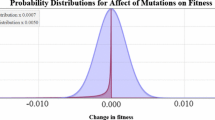Summary
For one stock ofD. simulans and two stocks ofD. melanogaster the percentage of females that produced viable progeny (i.e. percent fertility) was measured at two female ages (50 and 72 hrs), for all combinations of six densities (20, 40, 80, 160, 320, 640 individuals) and three species frequencies (20, 80, 100%). Significant differences were recorded between species and betweenD. melanogaster stocks. Increasing density significantly reduced fertility forD. simulans but not for either of theD. melanogaster stocks. Although species frequency had no effect, the associated stock ofD. melanogaster influencedD. simulans fertility to a high degree—theOr-R-C stock reducingD. simulans fertility because of physical interference, this interference being particularly evident at low densities.
Similar content being viewed by others
References
Barker, J.S.F.: Adult population density, fecundity and productivity inDrosophila melanogaster andDrosophila simulans. Oecologia (Berl.)11, 83–92 (1973)
Bastock, M.: A gene mutation which changes a behaviour pattern. Evolution10, 421–439 (1956)
Burnet, B., Connolly, K., Beck, J.: Phenogenetic studies on visual acuity inDrosophila melanogaster. J. Insect. Physiol.14, 855–860 (1968)
Burnet, B., Connolly, K., Dennis, L.: The function and processing of auditory information in the courtship behaviour ofDrosophila melanogaster. Anim. Behav.19, 409–415 (1971)
Claringbold, P.J., Barker, J.S.F.: The estimation of relative fitness ofDrosophila populations. J. theor. Biol.1, 190–203 (1961)
Connolly, K., Burnet, B., Sewell, D.: Selective mating and eye pigmentation. An analysis of the visual component in the courtship behaviour ofDrosophil melanogaster. Evolution23, 548–559 (1969)
Crossley, S., Zuill, E.: Courtship behaviour of someDrosophila melanogaster mutants. Nature (Lond.)225, 1064–1065 (1970)
Gilliland, F. R., Jr., Davich, T. B.: Influence of population density on mating behaviour of chemosterilised, untreated, or over-wintered boll weevils,Anthonomus grandis. Ann, entomol. Soc. Amer.61, 834–836 (1968)
Hardeland, R.: Lighting conditions and mating behaviour inDrosophila. Amer. Naturalist105, 198–200 (1971)
Hosgood, S.M.W., Parsons, P.A.: Mating speed differences between Australian populations ofDrosophila melanogaster. Genetica36, 260–266 (1965)
Hosgood, S. M. W., Parsons, P. A.: Genetic heterogeneity among the founders of laboratory populations ofDrosophila melanogaster. II. Mating behaviour. Aust. J. biol. Sci.20, 1193–1203 (1967)
Koref-Santibanez, S., Iturra, P.: Adult density and mating activity inDrosophila gaucha andDrosophila pavani. Drosoph. Inf. Serv.46, 103–104 (1971)
LeCato, G.L., III, Pienkowski, R. L.: Frequency and duration of mounting and copulation by the Alfalfa weevil in the laboratory. Ann. entomol. Soc. Amer.63, 1548–1552 (1970)
Parsons, P. A., Kaul, D.: Variability within and between strains for mating behaviour parameters inDrosophila pseudoobscura. Experientia (Basel)23, 131–132 (1967)
Shorey, H. H., Bartell, R. J.: Role of a volatile female sex pheromone in stimulating male courtship behaviour inDrosophila melanogaster. Anim. Behav.18, 159–164 (1970)
Spiess, E. B.: Courtship and mating time inDrosophila pseudoobscura. Anim. Behav.16, 470–479 (1968)
Spiess, E. B., Langer, B.: Mating speed control by gene arrangements inDrosophila pseudoobscura homokaryotypes. Proc. nat. Acad. Sci. (Wash.)51, 1015–1019 (1964)
Spiess, E. B., Sherwin, R. N., Yacher, T.: Mating propensity of gene arrangement carriers from a Redwoods population ofDrosophila persimilis. Evolution25, 461–470 (1971)
Spiess, E. B., Spiess, L. D.: Mating propensity, chromosomal polymorphism, and dependent conditions inDrosophila persimilis. II. Factors between larvae and between adults. Evolution23, 225–236 (1969)
Spieth, H. T., Hsu, T. C.: The influence of light on the mating behaviour of seven species of theDrosophila melanogaster species group. Evolution4, 316–325 (1950)
Author information
Authors and Affiliations
Rights and permissions
About this article
Cite this article
Moth, J.J. Density, frequency and interspecific competition: Fertility ofDrosophila simulans andDrosophila melanogaster . Oecologia 14, 237–246 (1974). https://doi.org/10.1007/BF01039795
Received:
Issue Date:
DOI: https://doi.org/10.1007/BF01039795




